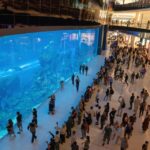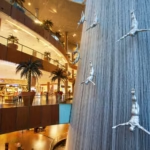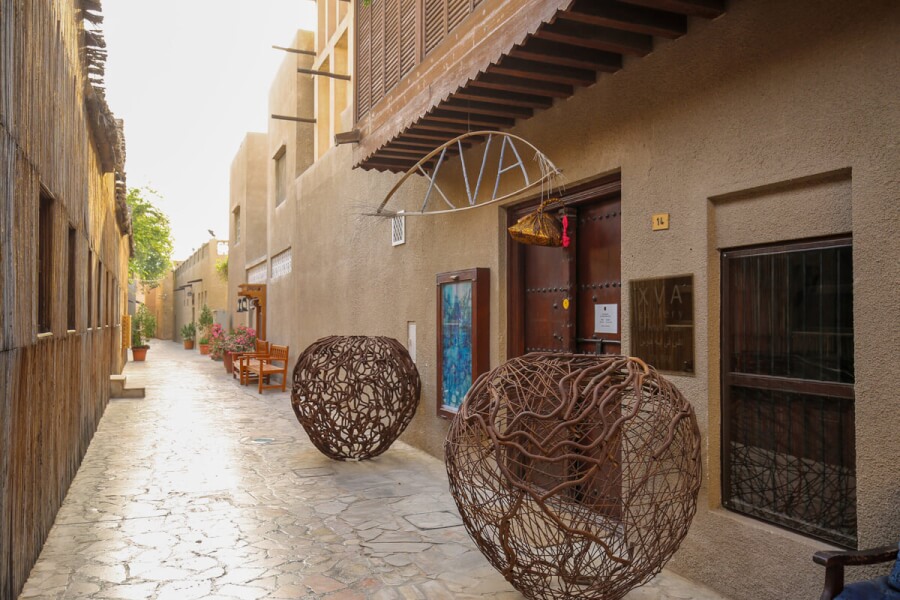
Al Fahadi Historical Neighborhood: Al Bastakiya
Introduction
Dubai’s Al Fahadi Historical Neighborhood is a true testament to the city’s roots and starkly contrasts the modern skyline that dominates the city’s landscape today. Nestled along Dubai Creek, this historic district is a living museum that transports visitors to a bygone era. From its well-preserved buildings to its bustling souks and charming streets, the neighborhood offers a unique opportunity to experience the rich tapestry of Dubai’s heritage.

Table Of Contents
Sustainability And Conservation
Personal Experience And Recommendations
Location And Setting
Located in the heart of Dubai’s Bur Dubai district, the Al Fahadi Historical Neighborhood is situated along the eastern shores of Dubai Creek. The neighborhood’s strategic location made it a vital trading hub in the early days of Dubai’s development. The setting of the neighborhood is characterized by narrow lanes, traditional wind towers, and intricate architecture that reflect the traditional Emirati style.
Surrounding the Al Fahadi Historical Neighborhood are several notable attractions. To the north, visitors can explore the Dubai Museum, housed in the Al Fahidi Fort, which provides a fascinating glimpse into the city’s history. The Dubai Creek, with its bustling abra (water taxi) crossings, lies to the east, offering picturesque views and the opportunity to take a traditional boat ride.
History And Origins
The history of Al Fahadi Historical Neighborhood can be traced back several centuries. It was initially a settlement established by Persian merchants who sought to take advantage of Dubai’s strategic location for trade. Over time, the neighborhood expanded and became a vibrant community inhabited by traders from various cultures and backgrounds.
During the mid-20th century, as Dubai began to modernize, many old buildings in the neighborhood were demolished to make way for contemporary developments. A local resident wrote to Prince Charles (now King) about what was happening. He visited Dubai and was shown the area, and advised the Dubai government to keep and restore it.
The government agreed on preserving Dubai’s cultural heritage and initiated restoration projects in the 1980s to revitalize the historic district. Today, Al Fahadi Historical Neighborhood is a testament to Dubai’s commitment to preserving its past and sharing it with the world.
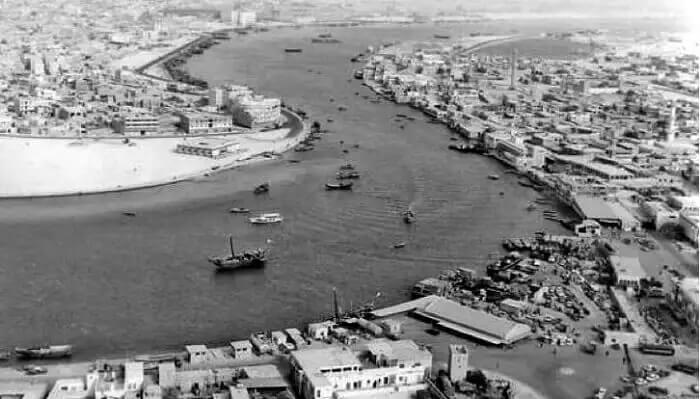
Landmarks And Attractions
One of the highlights of exploring the Al Fahadi Historical Neighborhood is discovering its landmarks and attractions. The neighborhood is home to the Sheikh Mohammed Centre for Cultural Understanding, where visitors can learn about Emirati traditions, customs, and etiquette through engaging cultural programs and guided tours.
Another prominent landmark is the Al Bastakiya Quarter, which showcases traditional courtyard houses with distinctive wind towers. These wind towers were designed to catch cool breezes and provide natural ventilation in the hot desert climate. The Al Bastakiya Quarter also houses several art galleries and cafés, making it a hub for creativity and relaxation.
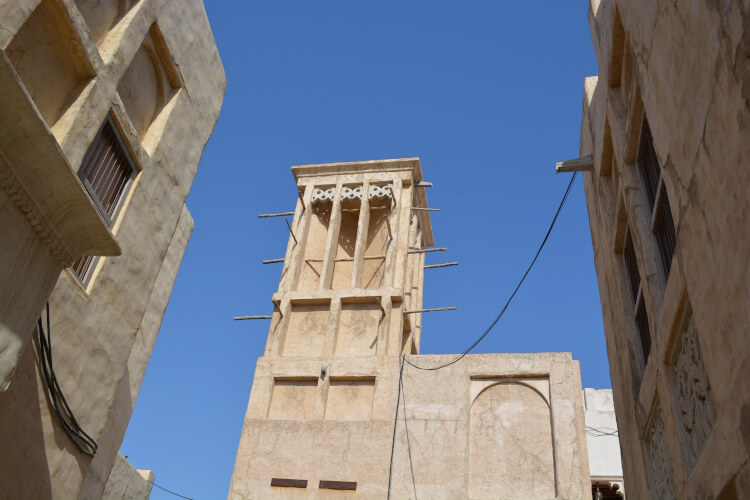
Within the neighborhood, you’ll also find the Al Fahidi Mosque, one of the oldest mosques in Dubai. Its stunning architecture, adorned with intricate floral patterns and calligraphy, is a testament to Islamic artistry. Visitors can respectfully explore the mosque and gain insights into Islamic traditions and practices.
Cultural Experience
Al Fahadi Historical Neighborhood is a hub of cultural experiences where visitors can immerse themselves in the rich heritage of Dubai. Traditional arts and crafts thrive in this district, with local artisans showcasing their pottery, weaving, and calligraphy talents. Visitors can witness these artisans at work and even participate in workshops to learn these traditional crafts.
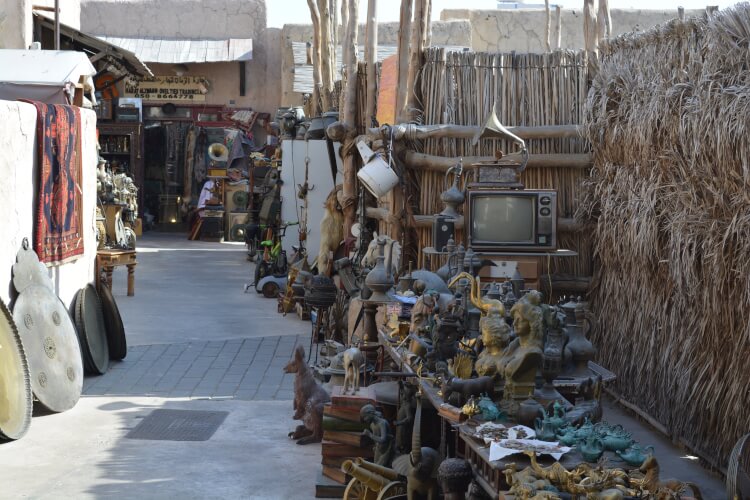
Music is an integral part of Emirati culture, and the neighborhood comes alive with melodies of traditional instruments such as the oud and the tabla. Local musicians often perform in the streets and cafes, filling the air with enchanting rhythms and melodies.
Al Fahadi Historical Neighborhood hosts festivals and events celebrating Emirati culture throughout the year. The Dubai Heritage Village Festival is a major highlight, offering a vibrant showcase of traditional music, dance, and handicrafts. These cultural experiences provide a deeper understanding of Dubai’s heritage and enduring traditions.
Street Life And Souks
As you wander through the winding streets of Al Fahadi Historical Neighborhood, you’ll encounter a vibrant tapestry of street life. The narrow alleyways are lined with shops, boutiques, and bustling souks that have been a cornerstone of Dubai’s trading culture for centuries.
The Textile Souk is a must-visit destination for fabric enthusiasts, offering a wide range of colorful textiles, silks, and intricate embroideries. Bargaining is integral to the experience, allowing visitors to engage with local traders and secure the best deals.
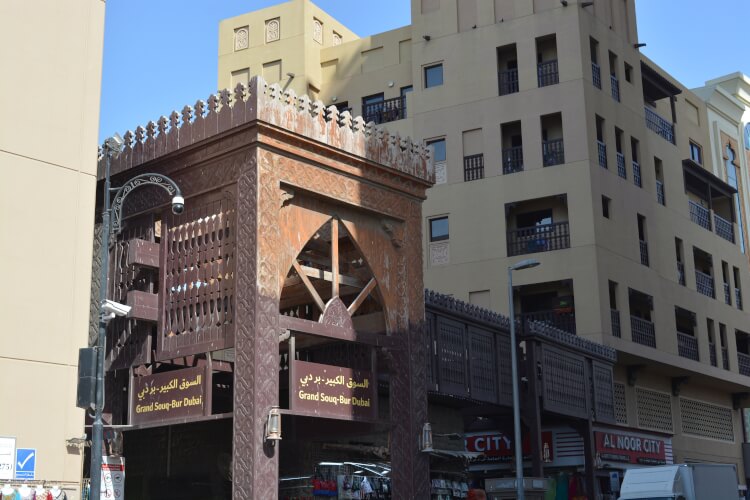
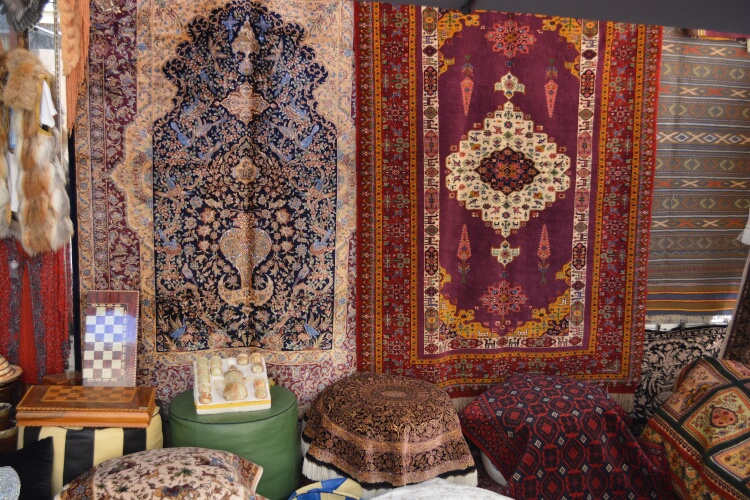
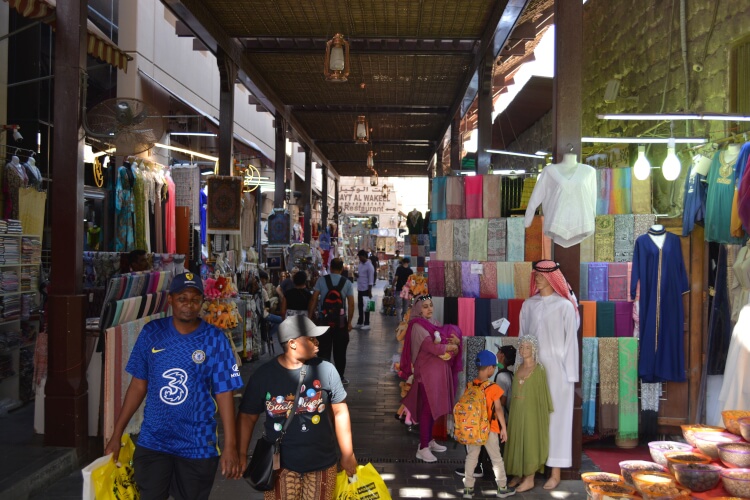
The Gold Souk is another iconic destination within the neighborhood, known for its dazzling array of gold and jewelry. Visitors can marvel at the intricate designs and craftsmanship on display or even purchase a piece of timeless beauty as a memento.
Food
Exploring Al Fahadi Historical Neighborhood is a feast for the eyes and a culinary delight. Emirati cuisine, influenced by Arabian, Persian, and Indian flavors, offers a unique gastronomic experience. Traditional dishes such as Machbous (spiced rice with meat or fish), Harees (wheat and meat porridge), and Luqaimat (sweet dumplings) tantalize the taste buds.
Local restaurants and eateries within the neighborhood serve authentic Emirati cuisine, allowing visitors to savor the flavors of the region. From cozy cafes serving aromatic Arabic coffee and dates to restaurants offering a fusion of traditional and contemporary dishes, there are options to suit every palate.
For those seeking a more immersive experience, exploring the food markets of Al Fahadi Historical Neighborhood is a must. The bustling markets are filled with fresh produce, spices, and local delicacies. Trying street food like Shawarma (grilled meat wrap) or indulging in traditional sweets like Umm Ali (bread pudding) provides a delightful culinary adventure.
Museums And Galleries
Al Fahadi Historical Neighborhood boasts a rich cultural scene with its museums and galleries that showcase the heritage and artistic endeavors of the region. The Majlis Gallery is a prominent art space in the neighborhood, featuring contemporary art exhibitions and installations celebrating local and international artistic talent.
The Dubai Museum, housed in the Al Fahidi Fort, offers a captivating journey through the city’s history. The museum displays artifacts, interactive exhibits, and lifelike dioramas, allowing visitors to learn about Dubai’s transformation from a small fishing village to a global metropolis.
Another noteworthy museum is the Coin Museum, which displays a vast collection of coins and currency from the region, shedding light on the economic history and trade routes that shaped Dubai’s development.
Accommodation Options
For those seeking an immersive experience in the Al Fahadi Historical Neighborhood, there are several accommodation options that allow visitors to stay within the heart of this enchanting district. Traditional guesthouses known as “heritage hotels” offer a unique glimpse into Emirati hospitality and provide a chance to experience the neighborhood’s charm firsthand.
These boutique hotels are often restored historic buildings, preserving their original architecture and ambiance while offering modern amenities for a comfortable stay. These intimate and personalized accommodations create a truly memorable experience, immersing guests in the neighborhood’s rich heritage.
Exploring The Surroundings
While Al Fahadi Historical Neighborhood itself offers a wealth of experiences, the surrounding areas are also worth exploring. Just a short distance away is the bustling district of Deira, known for its traditional markets, such as the iconic Gold Souk and the vibrant Perfume Souk. Visitors can take a traditional abra ride across the creek and immerse themselves in the lively atmosphere of this vibrant district.
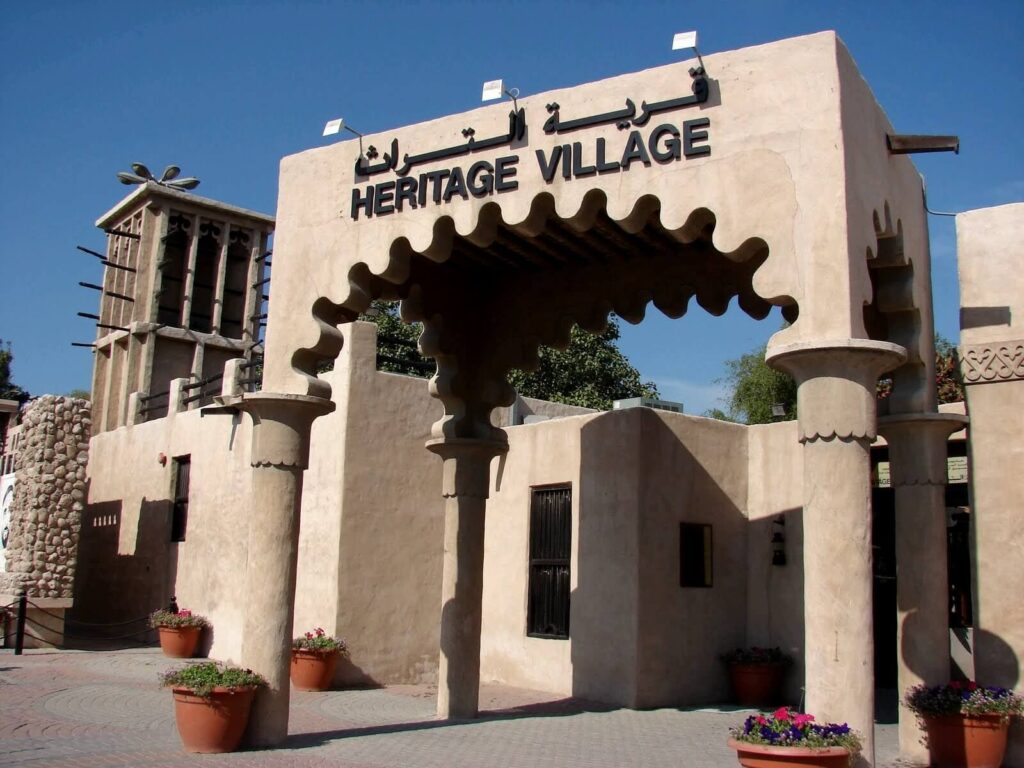
Visiting the nearby Dubai Heritage Village is highly recommended, providing a deeper understanding of Emirati culture through interactive displays, traditional performances, and informative exhibitions. The village is designed to recreate a traditional Bedouin settlement, showcasing the traditional way of life in the region.
For those seeking a touch of nature, the Dubai Creek Park offers a tranquil retreat with its lush greenery, picnic spots, and stunning views of Dubai Creek. The park is ideal for relaxing, enjoying a leisurely stroll, or even taking a boat ride along the creek to admire the city skyline from a different perspective.
Additionally, within a short distance from Al Fahadi Historical Neighborhood, visitors can explore the Dubai Spice and Gold Souks in Deira, where they can immerse themselves in the vibrant market atmosphere and indulge in shopping for spices, gold, and other traditional items. The Dubai Frame, a magnificent architectural landmark, offers panoramic views of both the historic and modern sides of Dubai, allowing visitors to appreciate the city’s transformation over the years.
Sustainability And Conservation
Preserving the cultural heritage and maintaining the sustainability of Al Fahadi Historical Neighborhood are crucial for its continued beauty and significance. In collaboration with heritage organizations, the Dubai government has implemented various conservation initiatives to ensure the neighborhood’s long-term preservation.
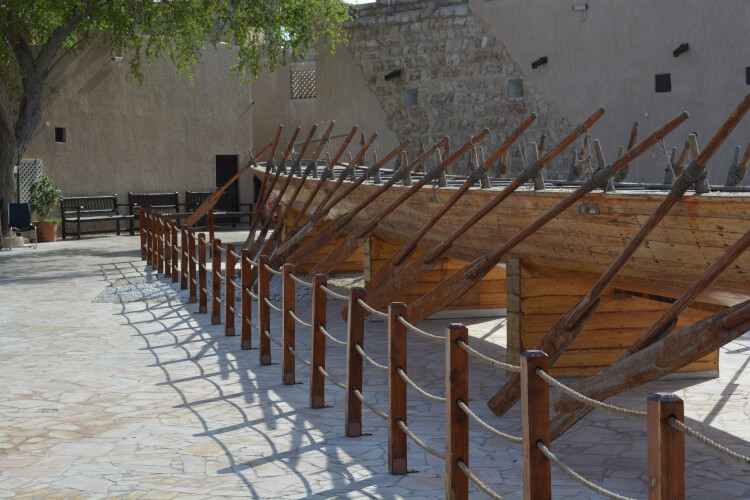
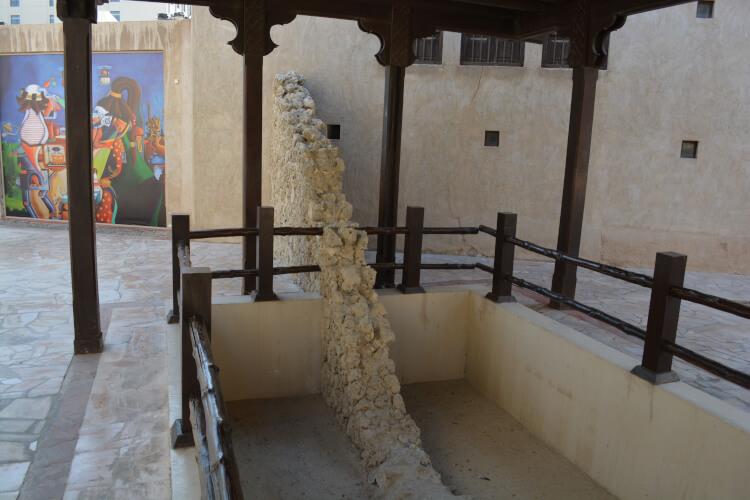
Efforts are made to restore and maintain the traditional architecture, ensuring that the unique charm and character of the neighborhood are preserved. Conservation projects also focus on promoting sustainable tourism practices, such as waste management and the use of eco-friendly materials.
Visitors are encouraged to support sustainability by respecting the neighborhood’s heritage, following designated paths, and avoiding.
Safety And Practical Tips
While exploring Al Fahadi Historical Neighborhood, it is essential to prioritize safety and be mindful of cultural norms. Here are some practical tips to ensure a smooth and enjoyable visit:
- Dress modestly and respectfully, particularly when visiting religious sites and mosques.
- Carry sun protection, as the neighborhood’s narrow streets may offer limited shade.
- Stay hydrated, and carry a water bottle with you.
- Respect the privacy and customs of the local residents.
- Take care when crossing the narrow streets, as some areas may have limited pedestrian infrastructure.
- Be cautious of pickpockets and keep your belongings secure.
- Follow any guidelines or instructions provided by museum staff or tour guides.
- If you arrive by car, please utilize designated parking areas, as street parking may have limitations.
- Check the opening hours of attractions and plan your visit accordingly.
- Engage with locals and tour guides to gain insights and recommendations for an enriching experience.
By being mindful of these tips, visitors can ensure their safety and make the most of their time in Al Fahadi Historical Neighborhood.
Personal Experience And Recommendations
Having had the opportunity to explore Al Fahadi Historical Neighborhood, I can confidently say that it is a captivating destination that takes you on a journey through Dubai’s rich history and cultural heritage. The authentic charm of the neighborhood, the warmth of its people, and the unique experiences it offers make it a must-visit when in Dubai.
One of my most memorable experiences was wandering through the narrow alleyways, soaking in the atmosphere, and stumbling upon hidden gems at every turn. Exploring the traditional souks and engaging in conversations with local traders allowed me to gain a deeper understanding of the neighborhood’s vibrant trading culture. It’s a really interesting place to visit and see how Dubai has evolved over the decades.
I highly recommend visiting the Sheikh Mohammed Centre for Cultural Understanding, where you can engage in enlightening conversations with Emirati hosts who share their personal stories and traditions. It offers a genuine and immersive cultural experience that fosters understanding and appreciation.
For photography enthusiasts, the Al Bastakiya Quarter provides a picturesque backdrop with its winding lanes, stunning architecture, and vibrant art scene. Exploring the area on foot and capturing its timeless beauty was an absolute delight.
To make the most of your visit, I suggest timing your trip to coincide with one of the neighborhood’s festivals or events, such as the Dubai Heritage Village Festival. These celebrations offer a vibrant showcase of Emirati traditions, music, dance performances, and traditional handicrafts, creating an atmosphere of joy and cultural celebration.
While in Al Fahadi Historical Neighborhood, don’t miss the opportunity to indulge in Emirati cuisine. Sample traditional dishes at local eateries, savor the aromatic flavors, and let your taste buds embark on a culinary journey. From the rich and flavorful spices to the delightful sweetness of traditional desserts, the gastronomic offerings will leave a lasting impression.
Lastly, take the time to appreciate the efforts to preserve and conserve the neighborhood. The restoration projects and sustainable practices ensure that future generations can continue to experience the beauty and authenticity of Al Fahadi Historical Neighborhood.
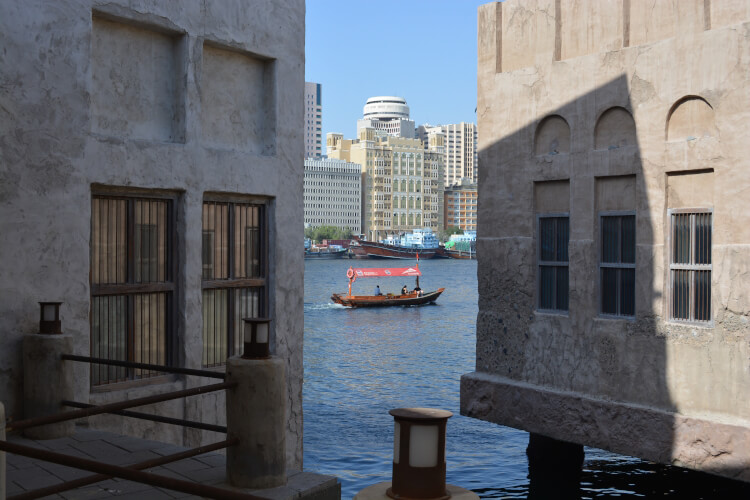
Transportation Links
Here are some transportation links to Al Fahadi Historical Neighborhood:
- Dubai Metro: The nearest Dubai Metro station to Al Fahadi Historical Neighborhood is Sharaf DG Station on the Green Line. From there, it’s a short walk to reach the neighborhood.
- Bus: Several bus routes connect to Al Fahadi Historical Neighborhood. Bus stops in the vicinity include Al Fahidi Metro Bus Stop, Al Ghubaiba Bus Station, and Al Seef Marine Transport Station.
- Taxi: Taxis are readily available in Dubai, and you can easily hail one to reach Al Fahadi Historical Neighborhood. Just provide the driver with the destination, and they will take you to the appropriate location.
- Ride-hailing services: Popular ride-hailing apps like Uber and Careem operate in Dubai, providing a convenient and reliable option to reach the neighborhood. Simply book a ride through the app and input Al Fahadi Historical Neighborhood as the destination.
- Water Taxi: For a unique experience, you can take a water taxi or an abra from various locations along Dubai Creek. These traditional boats offer a scenic and leisurely way to reach the neighborhood, mainly if you’re coming from areas like Deira or Bur Dubai.
- Walking: Al Fahadi Historical Neighborhood may be within walking distance, depending on your location. If you’re staying in the nearby areas or hotels, consider taking a pleasant stroll to immerse yourself in the neighborhood’s atmosphere.
Al Fahadi Historical Neighborhood Conclusion
Al Fahadi Historical Neighborhood stands as a captivating testament to Dubai’s rich cultural heritage. Its narrow lanes, traditional architecture, bustling souks, and vibrant street life immerse visitors in the city’s past while celebrating its present. From exploring museums and galleries to savoring the flavors of Emirati cuisine, every aspect of the neighborhood offers a unique and enriching experience.
As you wander through the streets, engage with the locals, and embrace the cultural traditions, you’ll develop a deep appreciation for Dubai’s history and the efforts made to preserve its heritage. The Al Fahadi Historical Neighborhood doesn’t merely remain a place frozen in time; instead, it actively embodies the city’s past and its aspirations for the future, making it a living, breathing testament.
FAQ
FAQs (Frequently Asked Questions)
- Is Al Fahadi Historical Neighborhood suitable for families with children?
- Yes, Al Fahadi Historical Neighborhood is suitable for families with children. They can explore traditional architecture, visit museums, and enjoy cultural experiences that are both educational and engaging.
- Yes, Al Fahadi Historical Neighborhood is suitable for families with children. They can explore traditional architecture, visit museums, and enjoy cultural experiences that are both educational and engaging.
- Are there guided tours available in Al Fahadi Historical Neighborhood?
- Yes, guided tours are available in Al Fahadi Historical Neighborhood. Local guides provide insights into the neighborhood’s history, culture, and significance, enhancing the overall experience.
- Yes, guided tours are available in Al Fahadi Historical Neighborhood. Local guides provide insights into the neighborhood’s history, culture, and significance, enhancing the overall experience.
- Can I purchase traditional handicrafts and souvenirs in Al Fahadi Historical Neighborhood?
- Absolutely! The neighborhood is home to various shops and boutiques where you can find traditional handicrafts, souvenirs, textiles, and artwork as mementos of your visit.
- Absolutely! The neighborhood is home to various shops and boutiques where you can find traditional handicrafts, souvenirs, textiles, and artwork as mementos of your visit.
- Are there any restrictions or dress codes when visiting Al Fahadi Historical Neighborhood?
- While there are no strict dress codes, it is advisable to dress modestly and respectfully, especially when visiting religious sites and mosques within the neighborhood.
- While there are no strict dress codes, it is advisable to dress modestly and respectfully, especially when visiting religious sites and mosques within the neighborhood.
- Can I capture photographs in Al Fahadi Historical Neighborhood?
- Yes, photography is allowed in most areas of the neighborhood. However, be respectful of local residents and seek permission before photographing people.
- Yes, photography is allowed in most areas of the neighborhood. However, be respectful of local residents and seek permission before photographing people.
- Is Al Fahadi Historical Neighborhood accessible for individuals with mobility limitations?
- The narrow lanes and uneven surfaces may pose challenges for individuals with mobility limitations. However, efforts are being made to improve accessibility within the neighborhood.
- The narrow lanes and uneven surfaces may pose challenges for individuals with mobility limitations. However, efforts are being made to improve accessibility within the neighborhood.
- Are there any events or festivals held in Al Fahadi Historical Neighborhood throughout the year?
- Al Fahadi Historical Neighborhood hosts various events and festivals celebrating Emirati culture. The Dubai Heritage Village Festival is a significant highlight, offering a vibrant showcase of traditional music, dance, and handicrafts.
- Al Fahadi Historical Neighborhood hosts various events and festivals celebrating Emirati culture. The Dubai Heritage Village Festival is a significant highlight, offering a vibrant showcase of traditional music, dance, and handicrafts.
- Can I visit Al Fahadi Historical Neighborhood during Ramadan?
- Yes, you can visit the neighborhood during Ramadan. However, be mindful of the cultural practices and observe respectful behavior during this holy month.
- Yes, you can visit the neighborhood during Ramadan. However, be mindful of the cultural practices and observe respectful behavior during this holy month.
- What is the best time to visit Al Fahadi Historical Neighborhood?
- The best time to visit is during the cooler months from November to March when the weather is pleasant for exploring the neighborhood on foot.
- The best time to visit is during the cooler months from November to March when the weather is pleasant for exploring the neighborhood on foot.
- Can I access Al Fahadi Historical Neighborhood by public transportation?
- Yes, Al Fahadi Historical Neighborhood is easily accessible by public transportation. The Dubai Metro is a convenient option, with Al Fahidi Station located nearby. From there, you can walk to the neighborhood or take a taxi.
- Yes, Al Fahadi Historical Neighborhood is easily accessible by public transportation. The Dubai Metro is a convenient option, with Al Fahidi Station located nearby. From there, you can walk to the neighborhood or take a taxi.
- Are there any nearby attractions that I can combine with a visit to Al Fahadi Historical Neighborhood?
- Yes, there are several nearby attractions that you can combine with your visit to Al Fahadi Historical Neighborhood. The Dubai Creek, Dubai Spice and Gold Souks in Deira, and the Dubai Frame are all within a short distance and offer unique experiences.
- Yes, there are several nearby attractions that you can combine with your visit to Al Fahadi Historical Neighborhood. The Dubai Creek, Dubai Spice and Gold Souks in Deira, and the Dubai Frame are all within a short distance and offer unique experiences.
- Is Al Fahadi Historical Neighborhood crowded with tourists?
- The level of tourist crowds in Al Fahadi Historical Neighborhood can vary depending on the time of year and day. It is advisable to visit during weekdays and outside peak tourist seasons for a more relaxed experience.
- The level of tourist crowds in Al Fahadi Historical Neighborhood can vary depending on the time of year and day. It is advisable to visit during weekdays and outside peak tourist seasons for a more relaxed experience.
- Can I experience traditional Emirati music and dance performances in Al Fahadi Historical Neighborhood?
- You can experience traditional Emirati music and dance performances in Al Fahadi Historical Neighborhood. Look for cultural events and festivals often featuring live performances showcasing the region’s rich artistic heritage.
- You can experience traditional Emirati music and dance performances in Al Fahadi Historical Neighborhood. Look for cultural events and festivals often featuring live performances showcasing the region’s rich artistic heritage.
- Is it possible to explore Al Fahadi Historical Neighborhood on a self-guided tour?
- Yes, exploring Al Fahadi Historical Neighborhood on a self-guided tour is possible. Grab a map or use a smartphone app to guide you through the winding streets and discover the hidden gems at your own pace.
- Yes, exploring Al Fahadi Historical Neighborhood on a self-guided tour is possible. Grab a map or use a smartphone app to guide you through the winding streets and discover the hidden gems at your own pace.
- Can I learn about the history and significance of Al Fahadi Historical Neighborhood through audio guides or informative signage?
- Yes, several attractions within Al Fahadi Historical Neighborhood provide audio guides and informative signage that offer insights into the history and significance of the area. These resources enhance the visitor experience and provide a deeper understanding of the neighborhood’s cultural heritage.
- Yes, several attractions within Al Fahadi Historical Neighborhood provide audio guides and informative signage that offer insights into the history and significance of the area. These resources enhance the visitor experience and provide a deeper understanding of the neighborhood’s cultural heritage.
Useful Links
- More details about the district can be found here
- Looking to visit Dubai? These are the entry requirements
- A general guide to Dubai can be found here.
- Want to check out some beaches in Dubai?
- Fancy some tasty food? Try these fine dining options.
- There are lots of interesting places to visit in Dubai.
- Where does Dubai come from? Check out the History of Dubai.
Key Takeaways
- Al Fahadi Historical Neighborhood in Dubai is a captivating destination that showcases the city’s rich cultural heritage and history.
- The neighborhood is known for its traditional architecture, narrow lanes, bustling souks, and vibrant street life.
- It offers a range of experiences, including exploring museums and galleries, indulging in Emirati cuisine, and shopping for traditional handicrafts.
- Public transportation provides easy access to Al Fahadi Historical Neighborhood, allowing visitors to conveniently explore the nearby attractions such as the Dubai Creek and Deira Spice and Gold Souks alongside their visit to the neighborhood.
- Visitors should respect local customs and dress modestly, especially when visiting religious sites.
- The neighborhood hosts events and festivals throughout the year, providing opportunities to experience traditional music, dance, and cultural performances.
- Sustainable practices and conservation efforts are in place to preserve the neighborhood’s heritage for future generations.
Al Fahadi Historical Neighborhood invites you to step back in time and immerse yourself in the vibrant tapestry of Dubai’s cultural legacy. From the labyrinthine alleyways to the bustling souks and the warmth of its people, every moment spent here is an opportunity to connect with the city’s essence. So, come and embark on a journey through time, where tradition and modernity intertwine to create a truly unforgettable experience.

